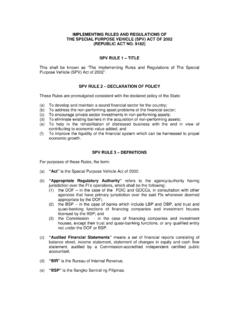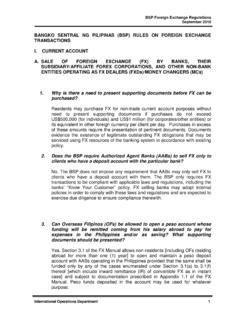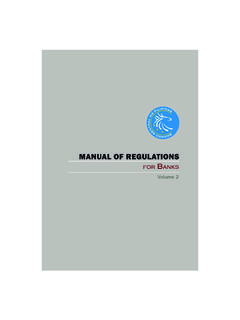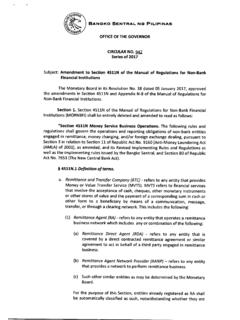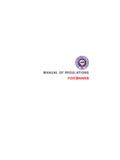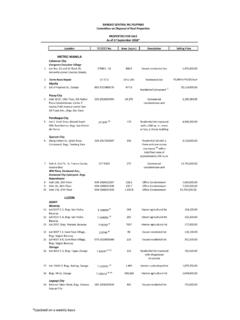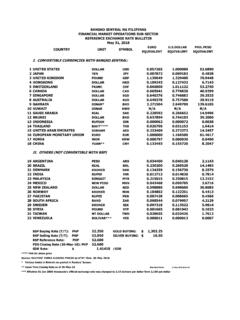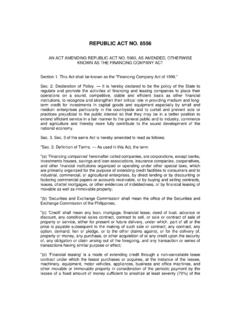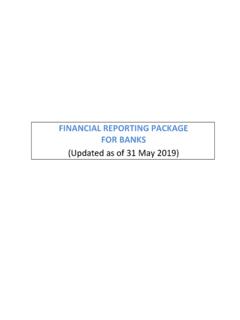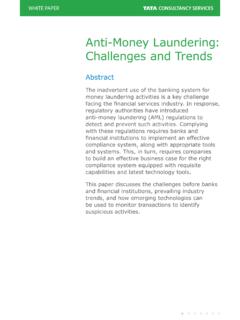Transcription of MEMORANDUM NO. M-2020- All BSP-Supervised Financial ...
1 OFFICE OF THE DEPUTY GOVERNOR Financial SUPERVISION SECTOR A. Mabini St., Malate 1004 Manila, Philippines * (632) 87087701 * * MEMORANDUM NO. M-2020- ___ To : All BSP-Supervised Financial Institutions (BSFIs) Subject : money laundering (ML)/Terrorist Financing (TF) Risk Assessment System (MRAS) The Monetary Board, in its Resolution No. 1461 dated 13 November 2020, approved the adoption of the money laundering (ML)/Terrorist Financing (TF) Risk Assessment System (MRAS) (Annex A). The MRAS is a tool to assess the inherent ML/TF and proliferation financing (PF) risk and the quality of risk management system to determine the net ML/TF/PF risk of BSFIs, taking into account their risk and context, business models and operations, among others.
2 The MRAS uses a four (4) point rating scale to describe the net ML/TF/PF risk, as follows: Net Risk Description High Excessive level of residual risk. The risk management and control framework is disproportionate and not commensurate with the high level of inherent risks posed by the nature and complexity of the BSFI s activities. Most likely to be used as a conduit for the proceeds of unlawful activities, TF and PF. Above average Substantial level of residual risk. The risk management and control framework is either acceptable, with certain areas for improvement, relative to high level of inherent risk, or is inadequate in critical aspects relative to the above average or lower level of inherent risk posed by the nature and complexity of the BSFI s activities.
3 May be used as conduit for the proceeds of unlawful activities, TF and PF. Moderate Manageable level of residual risk. The risk management and control framework is sufficiently compatible or commensurate with the level of inherent risks posed by the nature and complexity of the BSFI s activities. Can withstand associated ML/TF/PF risks and there is low to moderate probability to be used for ML/TF/PF activities. Low Marginal level of residual risk. The risk and control framework is robust and/or fully compatible with the level of inherent risks posed by the nature and complexity of the BSFI s activities.
4 Highly capable of withstanding ML/TF/PF risks and curbing ML/TF/PF activities. The MRAS will replace the existing AML risk rating system (ARRS) and will be implemented along with the Supervisory Assessment Framework (SAFr). For information and guidance. CHUCHI G. FONACIER Deputy Governor 23 November 2020 Att: a/s Annex A money laundering (ML)/TERRORIST FINANCING (TF) RISK ASSESSMENT SYSTEM (MRAS) The MRAS is a tool to assess the ML/TF and proliferation financing (PF) risk profile of BSP-Supervised Financial institutions (BSFIs), taking into account their risk and context, business models and operations, among others.
5 The MRAS provides the platform for assessing the level of inherent ML/TF/PF risks and the quality of risk management and self-assessment systems of BSFIs, to arrive at their net ML/TF/PF risk profile. The net results will serve as a basis for determining the frequency and scope of examinations as well as the type, intensity, and intrusiveness of supervisory activities. The following will be assessed under the MRAS: Inherent risk. This refers to the intrinsic ML/TF/PF risks arising from the BSFI s business and relationships, considering key elements such as nature of the products or services offered, profile of clients or business relationships, delivery channels, as well as the geographical location of the BSFI, its customers and counterparties.
6 Quality of risk management. This refers to the quality of Board and senior management oversight, adequacy of the money laundering and terrorist financing prevention program (MTPP), and effectiveness of internal controls and implementation of key anti - money laundering /countering the financing of terrorism/ countering proliferation financing (AML/CFT/CPF) processes. The said key processes include, onboarding customer due diligence (CDD), ongoing monitoring of accounts and transactions, targeted Financial sanctions , covered and suspicious transaction reporting, record keeping, and AML/CFT training program, among others.
7 Self-assessment systems. This refers to the compliance and internal audit functions. Net ML/TF/PF risk The residual risk after considering the mitigating effects of risk management. I. Inherent Risk Assessment A four (4) point rating scale shall be used to assess inherent risk as follows: High Excessive level of inherent risk related to identified factors Above average Substantial level of inherent risk related to identified factors Moderate Manageable level of inherent risk related to identified factors Low Marginal level of inherent risk related to identified factors The assessment shall begin with understanding the level of the ML/TF/PF risks of the BSFI, or the extent of its vulnerabilities to ML/TF/PF activities, arising from its business and/or relationships.
8 The factors that will be considered in the assessment include total size and Annex A Page 2 of 7 value of the relevant products/services, nature of products or services, client base profile, delivery channels, and geographical location of its offices, customers and/or counterparties: a. Total size and value of the products and services This factor indicates the ML/TF/PF vulnerability of a product or service based on the magnitude or volume and value of transactions. The large volume and high value of the product or activity make it easier to conceal the high amount of proceeds from illegal activities.
9 B. Nature of products/services This factor indicates the ML/TF/PF vulnerability of the BSFI considering the intrinsic nature and complexity of the products or services it offers. It includes an assessment of the level and extent of the BSFI s high risk products or services, such as correspondent banking services, electronic wire/funds transfers, private banking, and those identified in the national, sectoral, and institutional risk assessments. c. Client base profile This factor indicates the level of inherent ML/TF/PF risk based on the nature, type, profile, geographical location, and/or behavior of customers that use or avail of the BSFI s products and services.
10 It also considers the extent of exposure to high risk customers. Customer risk profile is assessed considering relevant factors, such as nature of product or service to be availed, source of funds and wealth, position and rank or stature, country of origin/residence, presence or absence of negative information, and other relevant factors. d. Delivery Channels This factor indicates the ML/TF/PF vulnerability considering the delivery channels and the level or degree of verification performed by the BSFI as part of CDD, the degree of anonymity in transacting, as well as the ease and speed of performing Financial transactions.
